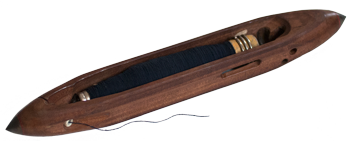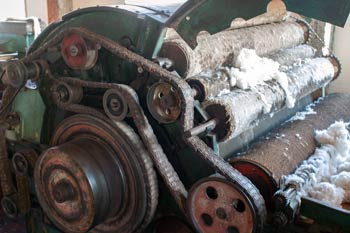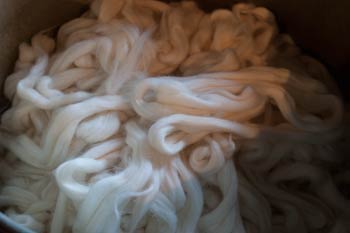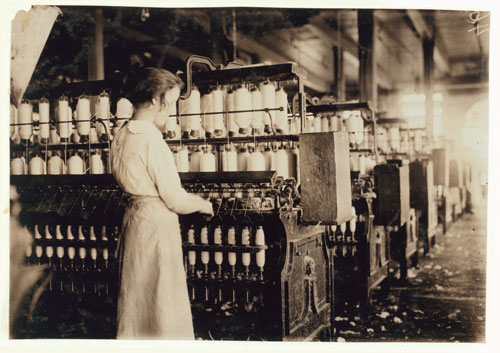
Cotton Mills of the Jones Falls
Power looms in operation, Boott Cotton Mill Museum, Lowell, Massachusetts. Note the “flying shuttle” as it flies across the loom. Explanations for the technical terms are in Steps in Milling Cotton
Automating Cotton Weaving and Spinning
Though similar, Steps in Milling Cotton is organized by the order of the processes, while Automating Cotton is organized in order of technological progress.
Cotton production wasn’t automated all at once; automation presented a series of problems that were solved as the need became pressing and the technology became available.
Between the late 1600s and the early 1700s, cotton cloth imported from India displaced linen and wool as the preferred fabric for the well-to-do in Britain. It did so because of cotton’s great beauty, its lightness, its ease of printing, and its price. At first, Britain forbid the importation of printed cotton (calico) to protect the wool, linen and hemp producers, but as British automation made British cotton goods more competitive, the embargo was lifted in the 1770s, and cotton manufacturing became all-important.
Traditional Weaving
Traditional weaving was done on a loom in the home, often on a freelance basis.
In a loom, a series of “warp” yarns run from a roll in the back of the loom to a take-up roll at the front of the loom. The warp yarn runs through two or more warp frames. Each frame allows a different set of warp yarns to be lifted up while others stay in place. When one set is lifted, the “woof” or “filling” yarn is then woven between the raised and unraised warp yarn. Then another set of warp yarns are raised and the fill yarn is woven back through. A comb-like device beats or “battens” the filling yarn firmly against the previously woven cloth, and it’s taken up on a roll. The changing pattern caused by raising and lowering the warp threads locks the threads together to create cloth.

Shuttle with quill containing filler yarn. It becomes a Flying Shuttle when levers throw it from one side of the loom to another. It became a projectile when one of the throwing arms on an automated loom broke and the Flying Shuttle flew across the room and embedded itself in the wall.
Flying Shuttle, 1733
The automation of weaving began with John Kay’s invention of the Flying Shuttle in 1733.
With Kay’s “Flying Shuttle,” rather than weavers using their hands to push the shuttle, the shuttle is thrown side-to-side, from one box-like cup to another, by the motion of a hand-operated lever. The Flying Shuttle increased the speed at which cloth could be woven and the width of cloth that could be made. (Previously, weavers were usually men because cloth could be no wider than the length of the weaver’s forearm.) Previously, spinning and weaving had been a family enterprise; but now that a weaver could weave yarn much faster than a spinner could spin yarn for the weaver, fewer weavers and more spinners were needed, upsetting the family unit.

Cotton carding machine, Slater Mill, R.I.

"Slivers" of cotton from the carding machine

A woman spinning cotton using a throstle spinner, c. 1910, photo by Lewis Wickes Hine [courtesy Library of Congress]
A Throstle Spinner in action at Slater Mill, Pawtucket, Rhode Island. It’s called a Throstle Spinner because the workers thought it made a sound like a British Song Thrush, commonly referred to as a Throstle.
Carding, 1748
In 1748, Lewis Paul of Birmingham, England invented the hand-driven carding machine. Small wires was inserted like a brush bristles into a blanket, which was then wrapped around a cylinder to make wire rollers. Raw cotton was fed into the carding machine, and by the action of one wire roller moving against another, the cotton was cleaned of impurities, the fibers of the cotton were aligned in one direction, and the cotton was turned it into a rope-sized “sliver” ready to be spun. Previously, the work had been done using two small hand-held cards (Wadsworth, Mann 419-448).
Spinning Jenny, 1765
The imbalance between the weavers and the spinners was relieved with the invention of the Spinning Jenny by Englishman James Hargreaves in 1765. Before that, a spinning wheel would only spin one spindle of yarn at a time; using human power, Hargreaves' Spinning Jenny could spin between six to 80 spindles at once, greatly increasing output.
Water Frame, 1769
The Spinning Jenny had one drawback — it created low quality yarn. The next major advance was the Water Frame (later known as a throstle spinner, because it sounded like the British Song Thrush, or “Throstle”), patented by Richard Arkwright in 1769. The Water Frame used water power (hence the name “water frame”) rather than human power. It also spun more spindles simultaneously than a Spinning Jenny. More importantly, it created a stronger yarn. However, since it was no longer human-powered — requiring a waterwheel, gearing, etc. — it wasn’t a device that could be used in the home. (Arkwright is also credited as the first person to create a factory that used a continuous process to take a raw substance — cotton — to a finished product — yarn — in a series of stages.) (Museum of Science & Industry)
Spinning Mule, 1779
The Water Frame was followed by the Spinning Mule, invented by Samuel Crompton. The Spinning Mule combined the best aspects of the Spinning Jenny and the Water Frame. The yarn it produced was equal to the finest hand-spun cotton from India.

Panoramic photo of an operating mule spinning machine, Slater Mill, Pawtucket, R.I. This machine can create 136 spindles of yarn at a time.
The Spinning Mule at Slater Mill in operation.
The Spinning Mule operates in two motions: 1) a carriage with the spindle attached to it moved out, pulling out a length of roving, stretched it to make it thinner and twisted it to make it stronger. Those actions turned the roving into yarn. 2) The carriage then moved back in, and the newly twisted yarn was wound onto the spindle before the next section was stretched. (See Spinning Mule video, right.)
Cotton Mills Come to America, 1790
All of the proceeding developments in cotton manufacturing were centered in England, which in the late 1700s was the textile manufacturer to the world. To maintain its manufacturing edge, English law forbid blueprints of cotton machines or workers with knowledge of how they were constructed from leaving the country.
But in 1790, Samuel Slater, an Englishman who had apprenticed at a cotton mill in England, emigrated to the U.S. He quickly became a partner in the building of the first cotton mill in U.S., known as Slater Mill, in Pawtucket, RI. The mill used water-powered machinery for carding and spinning cotton. Slater eventually owned several mills and became one of the wealthiest men in America. He is still referred to in England as “Slater the Traitor.”
Steam Power, 1781
Initially, the looms were powered by water wheels and then water turbines. These turned a series of central shafts that ran the length of the rooms of the mill. Individual machines were driven by leather belts connected to the central shafts.
Water-powered spinning equipment required a river, so was dependent on the seasons and subject to droughts and floods. The first steam engine suitable for powering a cotton mill was built in 1769 by James Watt, and the first steam-powered cotton spinning mills in England started operation in 1781. An example of an early steam engine in service can be seen in this video of Bancroft Mill Engine, Barnoldswick, Lancashire, England.
Converting to steam power required burning tons of coal. Though coal could be moved from the coal fields in West Virginia to Baltimore by horse and wagon using the National Road (now the route of I-70), it was expensive to haul. Once the Baltimore and Ohio (B&O) Railroad reached the coal fields of West Virginia in 1842, steam power for the cotton mills became inexpensive. The first steam powered cotton mill was Woodberry Mill in 1843 (Richardson 256).
Cotton seeds are difficult to remove from the raw cotton fibers. The cotton gin removes the seeds using a series of teeth to pull the cotton fibers through channels too small for the seeds, leaving the seeds behind. The development of the hand-cranked cotton gin revolutionized the removal of seeds from raw cotton. Cotton gin from Slater Mill, Rhode Island.
Cotton Gin, 1793
Cotton fibers come from the flower of the cotton plant. When the flower ripens, the bole is picked and the cotton can be easily extracted. But cotton seeds are so embedded in the fibers that removing them by hand is slow and tedious. While traveling in the South, Eli Whitney saw early machines for extracting seeds and came up with his own solution. The cotton gin he invented removed seeds from the fiber using saw-like blades that pulled the fibers through passageways too small for the seeds, leaving the seeds behind. The cotton gin could de-seed as much cotton in an hour as a field-hand could in 600 hours. This made large-scale manufacture of cotton practical. [And arguably prolonged the existence of slavery. —DN]
In 1791, U.S. cotton production was only 2 million pounds of the fiber. With the cotton gin, by 1801 annual production reached 48 million pounds, and by the 1860s it stood at 1,650 million pounds. As of 1830s, the United States produced the majority of the world's cotton, and cotton exports exceeded the value of all other U.S. exports combined (Oyangen).
Power Looms, 1787-1815
In 1787, Edmund Cartwright, a minister, patented the first power loom. Adoption was slow at first, not because of any problem with the cloth it produced, but because arson and threats from local hand weavers frightened manufacturers away (Peacock). Power looms saw use starting around 1815, and in 1830 Richard Roberts built the first practical power loom. After this, looms again consumed yarn faster than the spinning machines of the time could spin it, but Roberts quickly followed up with a fully-automated Spinning Mule in 1831.
With the invention of the power loom and the power Spinning Mule, spinning and weaving shifted from a skilled craft to factory work for semi-skilled laborers — former farm workers, women, and children.
Electricity, 1883
Thomas Edison invented the electric light bulb in 1879. By November of 1883, according to the Maryland Journal of Towson, there was electric light at Mount Vernon Mill, and an electric plant was installed at the rear of Berry's Hall in Woodberry as of February 7, 1891, according to the Journal of that date. Electricity was usually installed in new mills and ones being updated. In 1904, when W. E. Hooper & Sons built Hooperwood Cotton Mill, it was the first fully electric cotton mill on the Jones Falls (Hooper). Mt. Vernon Mills were electrified in 1917 (McGrain 598). Early electric motors drove the central shafts formerly run by water or steam, but soon individual motors drove the machinery directly.